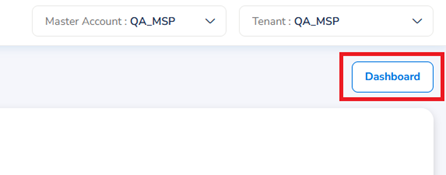Onboarding for Azure Enterprise Agreements (EA)
Please read first:Before proceeding with onboarding for this type of cloud account, you must ensure the required pre-onboarding steps have been completed first.
For more information on what these prerequisites are and how to address them, please refer to the Pre-Onboarding for Azure Enterprise Agreements (EA) user guide.
Introduction
An Azure Enterprise Agreement (EA) account allows enterprises under an Azure Enterprise Agreement to access and manage their Azure resources and billing data programmatically through applications.
The account onboarding process follows a step-by-step flow with five steps, described in the list below. Users must complete every step by filling in the appropriate details so that they can proceed to the next step.
The onboarding flow for Azure cloud accounts covers the following main steps:
- Azure Cloud Account Type: Select the type of Azure cloud account that needs to be onboarded.
- Prerequisites: Select the cloud account scope, access type, and product(s).
- Add & Validate Credentials: Select the authentication type and provide the required Azure account credentials.
- Basic Settings: Select and/or input the basic settings for the cloud account.
- Advanced Settings (optional): This optional step allows users to add tags and set up any required governance configurations. Account governance configurations can also be done after the onboarding steps.
As users add all necessary details for each step in the onboarding flow, it will be marked as completed and no longer appears greyed out in the left sidebar.
Detailed onboarding steps are explained in the sections below.
Note:Before starting the onboarding process on the platform, make sure that you have followed and completed all the prerequisite steps in the Azure cloud portal. Refer to the PRE-ONBOARDING user guides for more information on how to complete these steps.
Enterprise Agreements Onboarding Steps
Perform the following steps to onboard an Azure Enterprise Agreement (EA Application):
Navigating to the Onboard Accounts Page
Log in to the platform and on the left menu bar, go to Settings > Onboard Accounts.
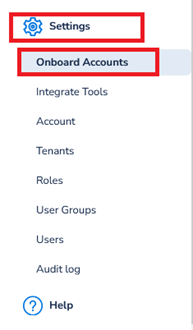
The Onboard Cloud Accounts starting page will appear. Here, users can select which cloud provider to onboard a new account for based on the available options.
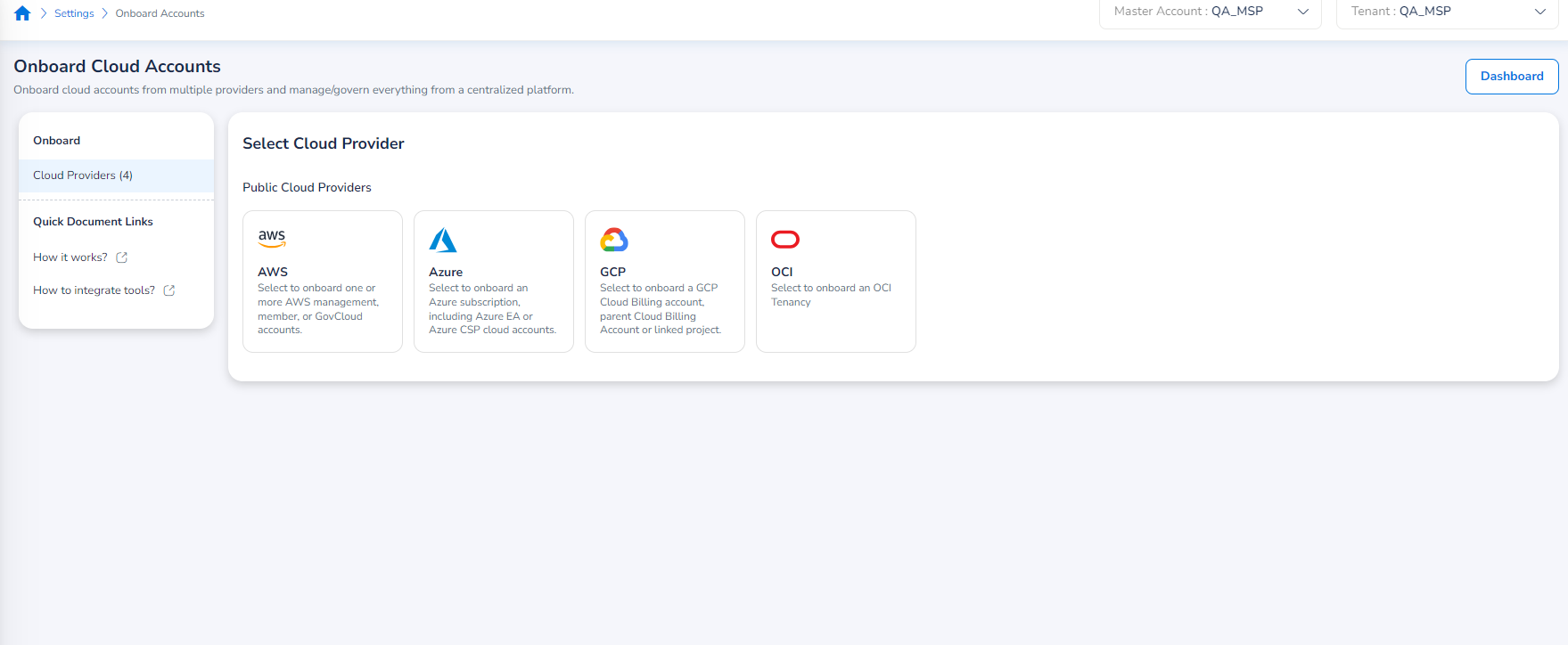
Note:Users can also use the Dashboard button in the upper right corner of the page to go directly to the Account Governance Dashboard (Cloud Accounts) as a shortcut.
Select Onboarding Option
To start the onboarding process, hover over the Azure option under Public Cloud Providers, and an Onboard button should appear. Select Onboard to proceed.
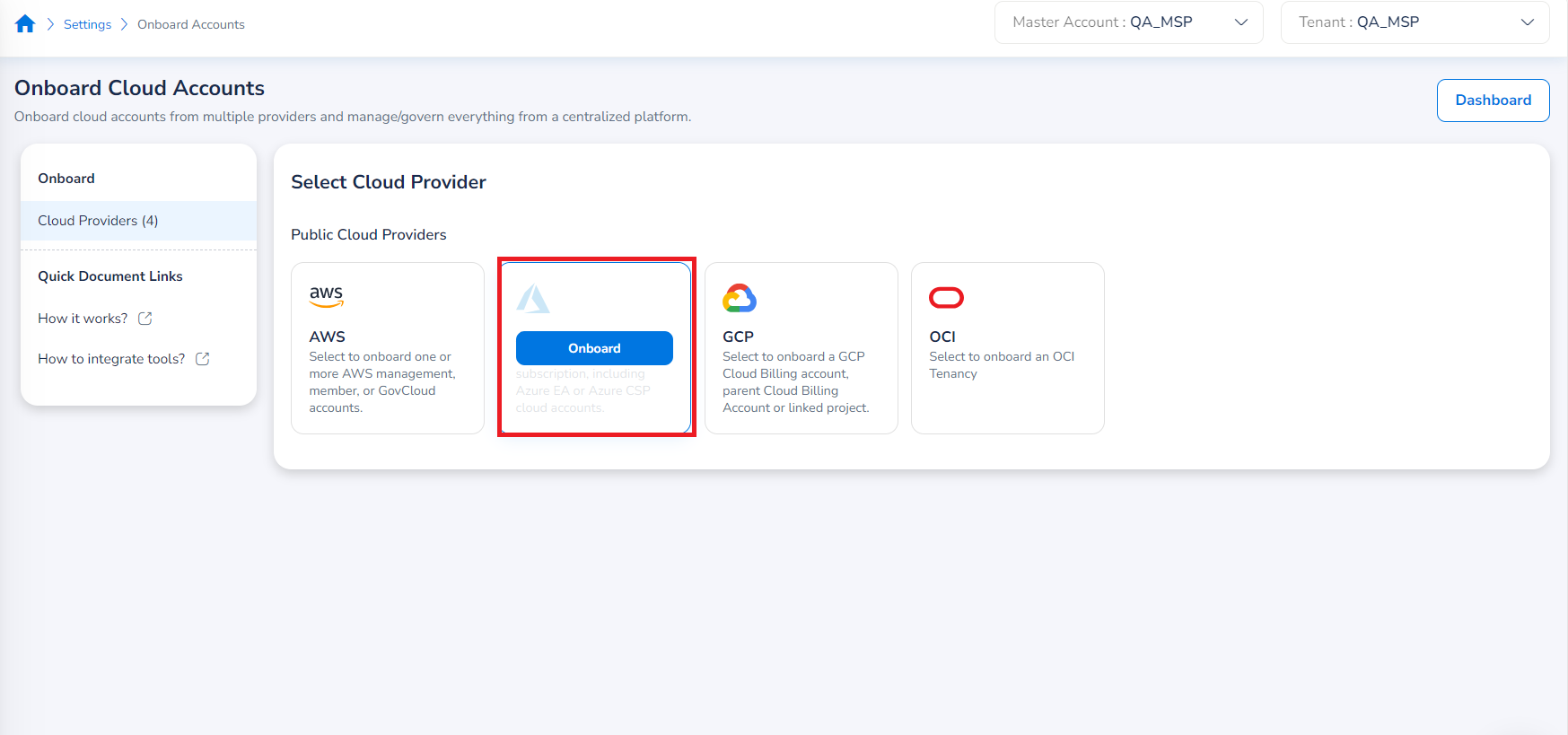
Select Cloud Account and Environment
Once you’ve selected the Azure option, the page for the first step of the onboarding workflow should appear – Azure Cloud Account Type. In this step, users must select the specific Azure cloud account type to onboard, along with the Azure environment type (if applicable).
You can select one of the following cloud account types to be onboarded:
- Subscription – Select to onboard an Azure Subscription. Best suited for enabling visibility and governance for a single cloud account.
- Enterprise Agreement (EA Application) – Select this option to onboard an Enterprise Agreement (EA) cloud account, which is typically used to manage multiple Azure Subscriptions and access reports.
- Microsoft Partner Agreement (CSP Direct) – Select this option to onboard an Azure Cloud Solution Provider (CSP) Direct cloud account.
And you can select one of the following environments to onboard a cloud account from:
- Azure Global – Select this option to onboard cloud accounts from the Azure public cloud environment.
- Azure Government – Select this option to onboard an Azure account from Azure Government cloud.

In this case, select Enterprise Agreement (EA Application) for the cloud account type, then either Azure Global or Azure Government, based on your needs.
Click Next. The Prerequisites section appears.
Prerequisites
In the Select Cloud Account Scope field, select one of the following options:
- Tenant: This scope allows the cloud account to be available only in the tenant it is onboarded to. This option is selected by default.
- Account: This scope allows the cloud account to be available in all tenants.
In the Select Access Type field, Read-Only is the only available option so it will be automatically selected:
- Read-Only: This option provides viewing access without the ability to make changes.
In the Select Product(s) field, FinOps is the only available option to be accessible for this cloud account type so it will automatically be selected.

Click Next. The Add & Validate Credentials section appears.
Add & Validate Credentials
In the Add & Validate Credentials section, fill the following fields:
- In the Enrollment ID box, type the enrollment ID.
- In the Tenant ID box, type the tenant ID.
- In the Application ID box, type the application ID.
- In the Application Secret box, type the application secret code.
- Click Save & Validate.
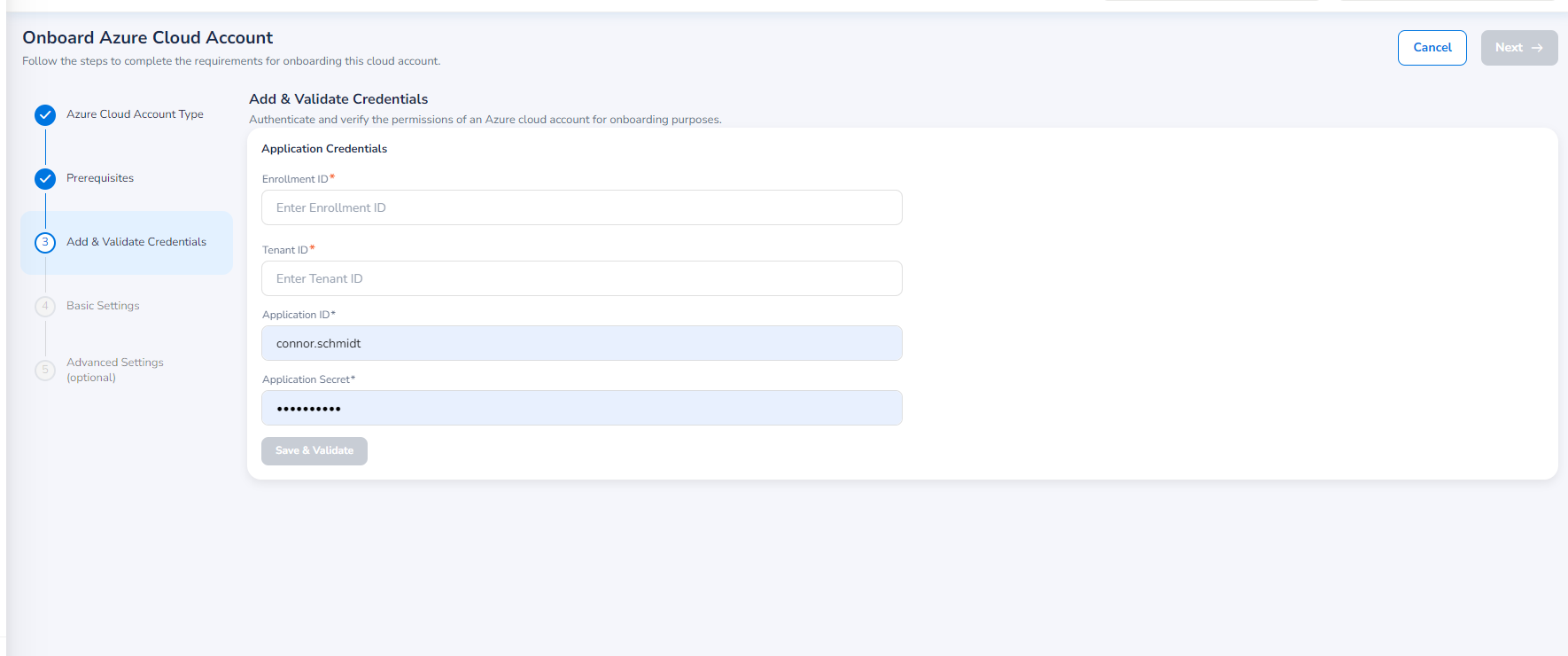
Validation
If the validation is successful, then a success message will be displayed.
If the validation fails, then an error message will be displayed along with an option for View Log. You can click View Log to view the error details and then click Re-Validate to retry the validation.
Note:After the completion of successful validation, the Save & Validate button turns to Re-Validate. You can click Re-Validate to validate the account again.
Click Next. The Basic Settings section appears.
Basic Settings
On the Basic Settings page, you’ll need to provide some basic details for the cloud account(s) being onboarded.
The following basic details can be provided on this page:
- In the Subscription list, select an appropriate account subscription.
- In the Storage Account box, type the storage account name.
- In the Report Path box, type a path where cost reports will be available.
- In the Account Name box, the account name will be pre-populated. Based on the need, this field can be modified.
- In the Currency list, click to select the currency in which the cost report will be downloaded from the cloud provider.
- Select the Privacy Policy checkbox to accept the terms and continue with the onboarding process.
Note:Please be aware that if you selected the Azure Government environment type for onboarding, only USD can be selected for the Currency field.
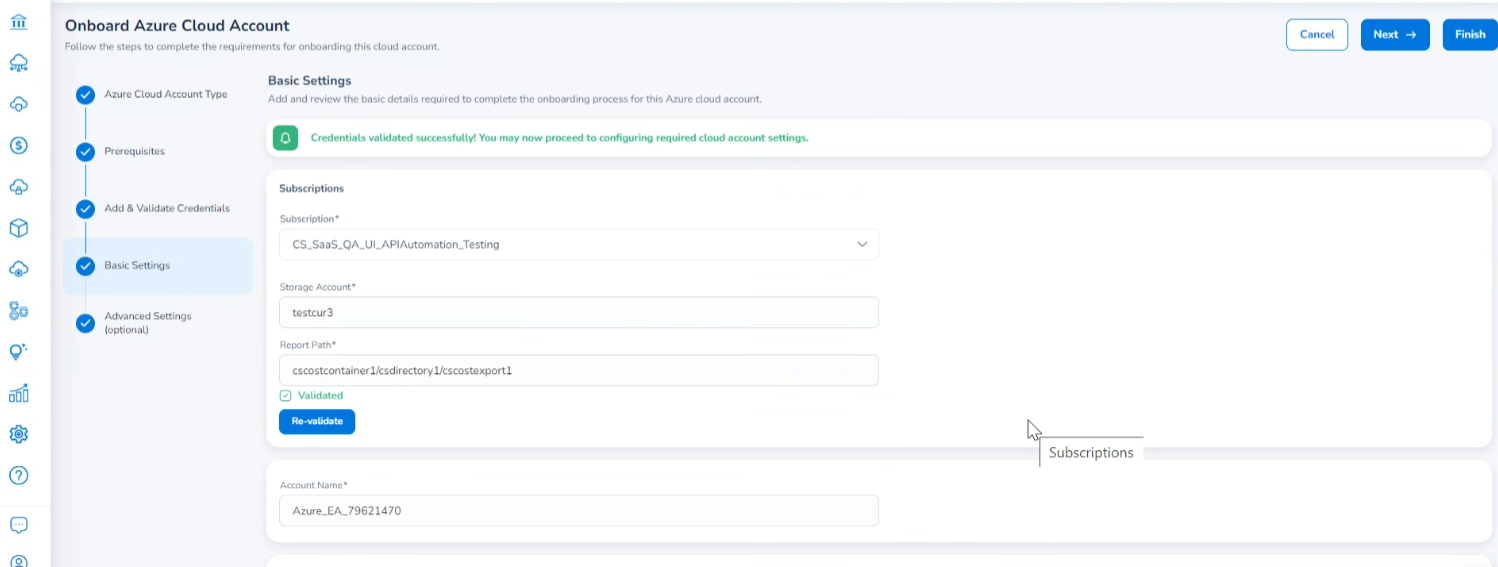
Note:The Account Name field should not exceed the maximum character limit of 50 characters including special characters.
You can click Next to set up advanced settings or click Finish to complete the account onboarding. Please note that the step for configuring advanced settings is not mandatory and can be skipped.
If you click Next, then the Advanced Settings section will be displayed.
Advanced Settings (Optional)
The Advanced Settings page is where users can make additional configurations of the cloud account being onboarded, like tags and governance settings. Again, this section is optional and can be completed later, if desired.
Add/Import Cloud Account Tags
In the Add/Import Cloud Account Tags section, do any of the following to fill in the tag details.
In the Custom Tags field:
- In the Key box, type the tag key.
- In the Value box, type the tag value.
- Lastly, click Add Tag. The added tag appears below.
When you click View Master Account/Tenant Tags, the Custom Tags dialog box opens where you can select the required tags and click Insert Selected Tags. The selected tags will now show up for the account to be onboarded.
Governance Configuration
In the Governance Configuration field, click Edit to configure the required settings. Refer to Governance Configuration for detailed steps.
Once you’re done with your configurations, select Finish.
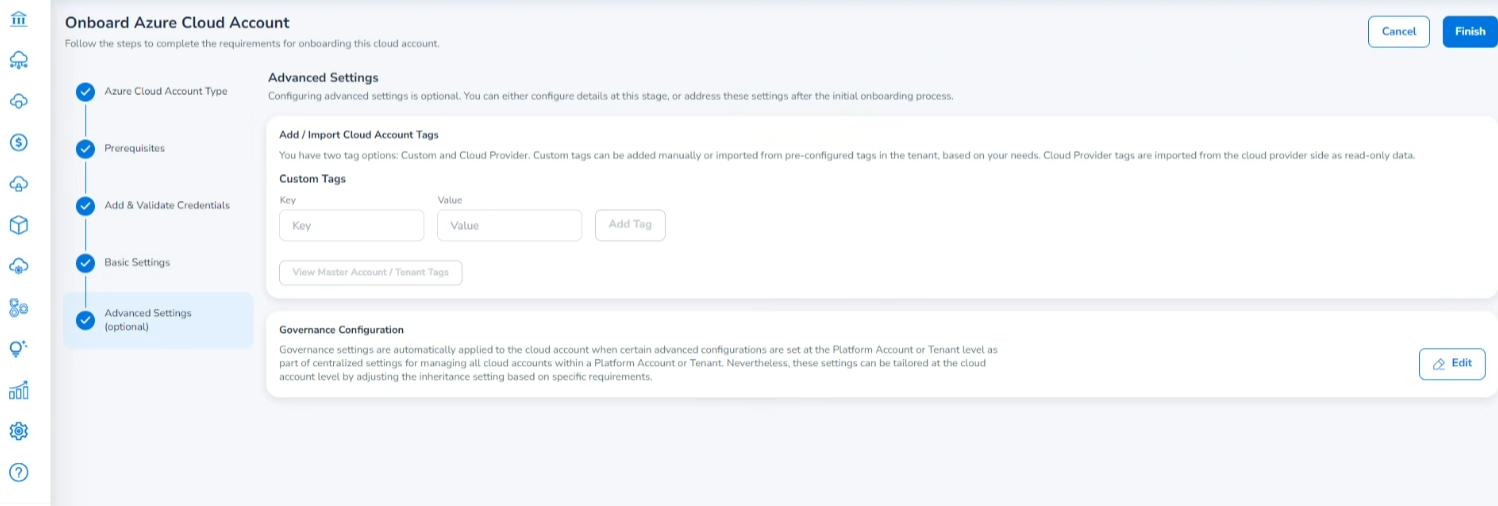
The Onboarding Status dialog box appears that shows the progress of account onboarding. You can click Go to the Dashboard to return to the Account Governance Dashboard.
Note:We request that users ensure any individual Subscriptions that are part of the Azure EA root account have not already been onboarded when onboarding the Azure EA root account. If you want all Subscriptions to be part of the Azure EA root account after onboarding it, please remove any individual Subscription first, then onboard the Azure EA root account.
If an individual Subscription has already been onboarded and is not required to be part of the EA root account, you can still onboard the EA root account without mapping the Subscription to it.
Please note that individual Subscriptions show PAYG costs, while Subscriptions onboarded under the EA root will reflect costs according to rates applied in the EA root account.
Governance Configuration
The Governance Configuration page includes many sections where configurations can be made. You need to select the configuration you want to apply to your onboarded account. All the available configuration sections are explained below. Refer to the relevant configuration and follow the steps. These governance configurations can be made while onboarding the account or can be done post onboarding.
FinOps
The configurations that can be done for FinOps are explained below.
Cost Anomaly
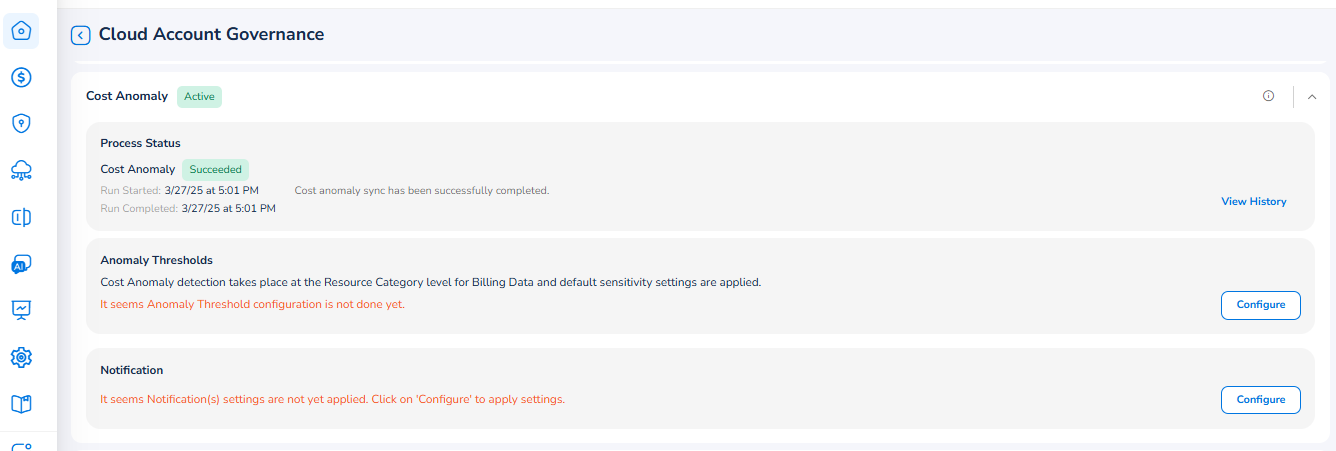
Perform the following steps to configure cost anomaly:
-
Expand the Cost Anomaly section.
-
In the Anomaly Threshold section, click Configure. The Create Anomaly Thresholds dialog box appears.
- Click Add Condition +.
- In the Anomaly Detection Scope filter, click to select either CloudAccount or ResourceCategory.
- If you select ResourceCategory, then the Resource Category filter appears. In the Resource Category filter, click the drop-down, select all applicable values, and then click Ok.
- Fill one of the following:
- In the Min. Cost Impact($) box, type the minimum cost impact value.
- In the Min. Cost Impact(%) box, type the minimum cost impact percentage and in the Min. Cost Spend($) box, type the minimum cost spend value.
- Click Save & Exit.
- You can click Add Condition + and add additional conditions.
-
In the Notification section, click Configure. The Notifications Settings dialog box appears.
- Select the Enable Notification checkbox. The Email Address, Webhook, and Microsoft Teams Webhook fields are displayed.
- In the Email Address box, type the email address of the user(s) and click Add.
- In the Webhook box, type the webhook link(s) and click Add.
- In the Microsoft Teams Webhook box, type the URL(s) for Microsoft Teams Webhook and click Add.
- Click Save & Apply.
Updated about 1 month ago
